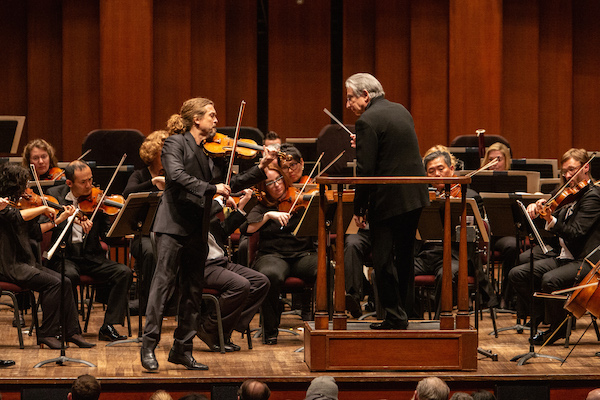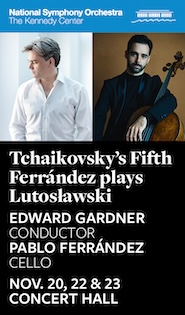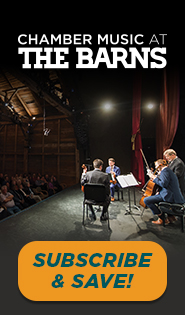A heroic sendoff for MTT with San Francisco Symphony’s memorable Beethoven

Christian Tetzlaff performed Mozart’s Violin Concerto No. 3 with Michael, Tilson Thomas and the San Francisco Symphony Saturday night at the Kennedy Center. Photo: Kim Huynh
Over a long tenure, the strengths of a music director can be imprinted on an orchestra. This was the feeling created by the latest visit of the San Francisco Symphony to the Kennedy Center Concert Hall since 2016, presented Saturday night by Washington Performing Arts.
The ensemble is in the midst of its fourteenth and final tour with music director Michael Tilson Thomas. After a quarter-century at the helm, next season will be the esteemed American conductor’s last, to be succeeded by Esa-Pekka Salonen.
In a gesture to their shared history, Tilson Thomas opened with one of his own compositions. He composed Agnegram in 1998, for the 90th birthday of Agnes Albert, a long-time patron of the orchestra. As Tilson Thomas explained in a brief spoken introduction, the musical themes spell out the letters of her name and the boisterous character of the piece reflects her nature and tastes.
Much of the work is a bustling march, assaulting the ears with a near-constant clangor of blaring brass, screeching piccolo, and noisy percussion. In that sense it served well in the role of room-clearing concert opener. Tilson Thomas added further whimsy in a new middle section, part of a 2016 revision to the piece, with a series of quotations from Schumann, Tchaikovsky, Verdi, and Irish lullabies.
German violinist Christian Tetzlaff joined the orchestra for Mozart’s Violin Concerto No. 3, in a performance that felt unsettled and out of synch with the ensemble. In the outer movements especially, Tetzlaff tended to rush ahead of the beat, creating minor misalignments that Tilson Thomas righted almost instantly and imperceptibly with his clear and calm gestures. The violinist’s impeccable technique made the supremely fast third movement a thrill.
The second movement stood out, more serenely paced and with Tetzlaff’s anxious vibrato creating a bittersweet, nostalgic quality. The violinist played cadenzas throughout of his own creation, which were a highlight, especially in the slow movement, featuring the whisper of Mozart’s quiet melodies over wispy double-stopped chords. His cadenza for the first movement combined that movement’s themes in a more challenging way, producing some intonation issues in the double-stop section there.
It was with the second half, given over to a magisterial performance of Beethoven’s Third Symphony (“Eroica”), that the strengths of the San Francisco Symphony came to the fore, in a performance that ranks among the finest this listener has ever heard. Tilson Thomas led with graceful but infallible gestures, concerned with longer musical arcs, indicated by smoothing gestures and always with an ear toward balance.
In the first movement this meant a focus on the legato nature of the main theme, in a rocking triple pattern, with the busier parts of the score bubbling underneath. Heeding their conductor’s hushing, the strings got out of the way of more important woodwind lines, and the beautiful horns came to the fore in the recapitulation section.
Tilson Thomas kept the second movement, a lengthy funeral march, moving ahead but without any sense of hurry, the ensemble always perfectly unified from the double-basses upward. Poignant oboe solos took center stage, and a heraldic major section blazed in sound. The Scherzo percolated crisply, the tempo bright but not overly fast, to make room for a much faster Finale. The horns handled their raucous moment in the spotlight in the Trio with aplomb.
The rapid tempo choice helped the orchestra create an impish Finale, with the emphasis on humor, including a dizzying flute solo. Even the fugal sections felt quirky and arch, with a charming section reduced down to solo string lines; the slow section was tender and nostalgic, with more distinctive woodwind solos.
An encore, Brahms’ Hungarian Dance No. 10 brought the concert full circle back to the boisterous opening piece in character, a parting wink from the conductor. The next chapter awaits for the San Francisco Symphony, but clearly this is an ensemble that has grown greatly under Tilson Thomas’s leadership.

